In today’s fast-paced and interconnected world, finding a sense of peace and connection with nature can be a challenge. However, the solution might be closer than you think. By planting and tending to your own garden, you can unlock the wonders of nature and experience a multitude of benefits for your mental, physical, and emotional well-being.
Gardening allows you to reconnect with the natural world and create a nurturing environment right in your own backyard. Whether you have a sprawling lawn or a small balcony, anyone can experience the joy of watching plants grow and thrive. So why should you plant a garden? Let’s explore the many reasons.
Key Takeaways:
- Planting a garden can provide a sense of peace and connection with nature in our fast-paced world.
- Gardening offers a multitude of benefits for mental, physical, and emotional well-being.
- Whether you have a large yard or a small balcony, anyone can experience the joy of gardening.
- From reducing stress to promoting sustainability, gardening has something to offer everyone.
- By growing your own food and incorporating native plants, you can contribute to a healthier ecosystem.
- Gardening can also bring aromatherapy benefits and provide a sense of accomplishment and pride.
- Learning about plants and their benefits can expand your knowledge and appreciation of the natural world.
- Enjoying fresh, homegrown produce and creating outdoor living spaces are additional rewards of gardening.
Gardening Benefits for Mental Health
Gardening isn’t just about growing plants; it’s a therapeutic journey that can significantly improve your mental health and well-being. By engaging in the act of gardening, you can connect with nature, reduce stress, and find a sense of purpose and fulfillment. Let’s explore the various ways gardening can benefit your mental well-being.
Connecting with Nature
Spending time in nature has been proven to have a positive impact on mental health. In today’s fast-paced and technology-driven world, taking a break from screens and immersing yourself in gardening allows you to connect with the natural world around you. It provides an opportunity to touch the earth, breathe in fresh air, and observe the beauty of plants and flowers.

Research has shown that spending time outdoors and engaging with nature can reduce symptoms of stress, anxiety, and depression. The sights, sounds, and smells of the garden can have a calming effect on the mind and promote a sense of peace and tranquility.
Reducing Stress and Improving Mood
Gardening has been found to be an effective stress reliever. The repetitive tasks involved in gardening, such as digging, planting, and watering, can help calm the mind and induce a state of relaxation. It provides a form of active meditation, allowing you to focus on the present moment and let go of worries and distractions.
The act of nurturing plants and watching them grow can also bring a sense of joy and accomplishment. Seeing your garden flourish can boost your self-esteem and improve your mood. It gives you a sense of purpose and a feeling of being connected to something greater than yourself.
Finding Purpose and Connection
Gardening provides a sense of purpose and accomplishment. It gives you a tangible goal to work towards and a sense of responsibility for the well-being of your plants. Seeing the fruits of your labor, whether it’s a beautiful flower blooming or a homegrown vegetable ready for harvest, can bring a deep sense of satisfaction.
Additionally, gardening can foster a sense of connection to the natural world and the cycle of life. It reminds us of our place in the ecosystem and the interdependence of all living beings. By nurturing plants and creating a welcoming habitat for wildlife, we can forge a deeper connection to the environment and feel more connected to the world around us.
Incorporating Aromatherapy into Your Garden
Aromatherapy, the practice of using scents to promote physical and emotional well-being, can be easily incorporated into your garden. Many aromatic herbs and flowers have therapeutic properties that can enhance relaxation, reduce stress, and improve mood.
For example, lavender is known for its calming effects and can help promote better sleep. Peppermint is invigorating and can help increase alertness and focus. Rosemary has been found to improve memory and cognitive function. By growing these plants in your garden, you can create a fragrant oasis that indulges your senses and promotes emotional well-being.
Learning and Growing
Engaging in gardening provides an opportunity for continuous learning and personal growth. As you delve into the world of plants, you’ll discover the diverse array of species and their unique benefits. Learning about different plants and their specific care requirements can expand your knowledge and deepen your appreciation for the natural world.
Gardening also encourages problem-solving and adaptability. You’ll encounter challenges such as pests, diseases, and changing weather conditions, which will require you to develop strategies to overcome them. This process of learning and problem-solving can improve cognitive skills and mental agility.
Overall, gardening is a therapeutic journey that can have a profound impact on your mental health and well-being. By connecting with nature, reducing stress, finding purpose and connection, incorporating aromatherapy, and embracing continuous learning, you can unlock the full potential of gardening as a tool for improving your mental well-being.
Growing Your Own Food for Health and Sustainability
Imagine the satisfaction of picking juicy tomatoes or crisp lettuce from your own backyard garden, knowing that you’re nourishing your body with fresh, pesticide-free food while also reducing your carbon footprint. Growing your own food through gardening is not only a rewarding experience but also a sustainable choice that has numerous benefits for your health and the environment.
Benefits of Growing Your Own Food
When you grow your own food, you have control over what goes into it. You can choose to grow your crops organically, avoiding the use of harmful pesticides and chemicals. This means that you can enjoy fresh, nutritious produce without worrying about the potential negative effects of conventional farming methods.
In addition to the health benefits, growing your own food can also save you money. Buying organic produce from the grocery store can be expensive, but with a garden, you can produce your own organic fruits, vegetables, and herbs at a fraction of the cost. Plus, you’ll have the satisfaction of knowing exactly where your food comes from and how it was grown.
Reducing Environmental Impact
Growing your own food is an eco-friendly choice. By eliminating the need for long-distance transportation, packaging, and refrigeration, you help reduce greenhouse gas emissions and lower your carbon footprint. Additionally, home gardens contribute to biodiversity by providing habitat for beneficial insects and wildlife, promoting a healthier and more balanced ecosystem.
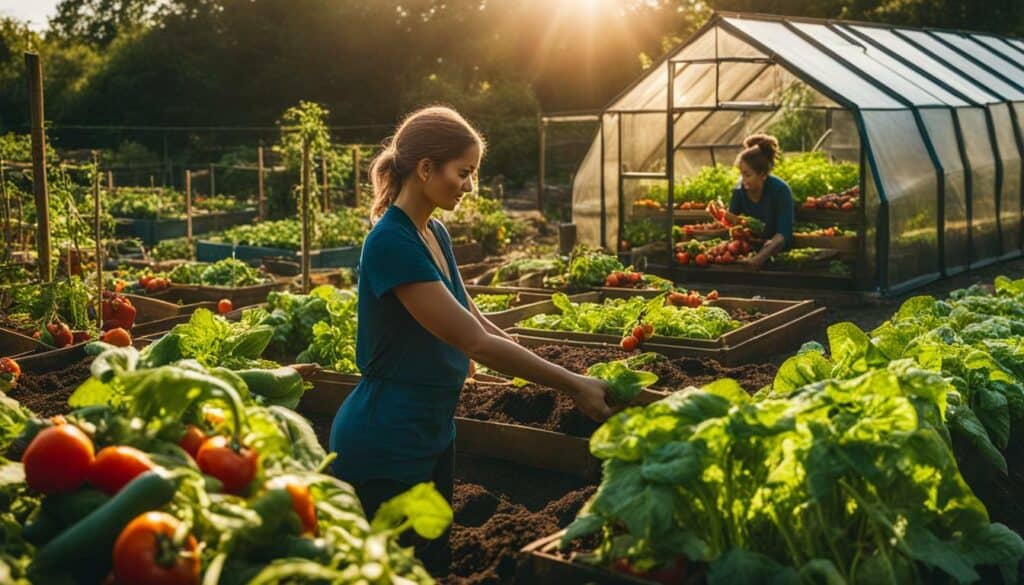
Getting Started
Starting a garden may seem intimidating at first, but with a few simple steps, you can be on your way to enjoying the rewards of homegrown food:
- Choose a sunny location for your garden, as most fruits and vegetables require at least 6 hours of direct sunlight per day.
- Prepare the soil by removing any weeds or grass and adding compost or organic matter to improve its fertility.
- Select the appropriate plants for your region and growing conditions. Consider factors such as space, climate, and the amount of time and effort you can dedicate to gardening.
- Water your plants regularly and provide them with the necessary nutrients through organic fertilizers or compost.
- Maintain your garden by pruning, weeding, and monitoring for pests and diseases. Implement organic pest control methods whenever possible.
Remember, gardening is a continuous learning process, and it’s okay to make mistakes along the way. Embrace the journey and enjoy the process of nurturing your plants and watching them flourish.
By growing your own food, you not only reap the nutritional benefits of fresh produce but also contribute to a more sustainable future. Start your garden today and experience the joy of harvesting and enjoying the fruits of your labor.
Getting Started: Gardening Tips for Beginners
Ready to dive into the world of gardening but not sure where to start? These helpful tips for beginners will guide you through the process of creating and maintaining a thriving garden.
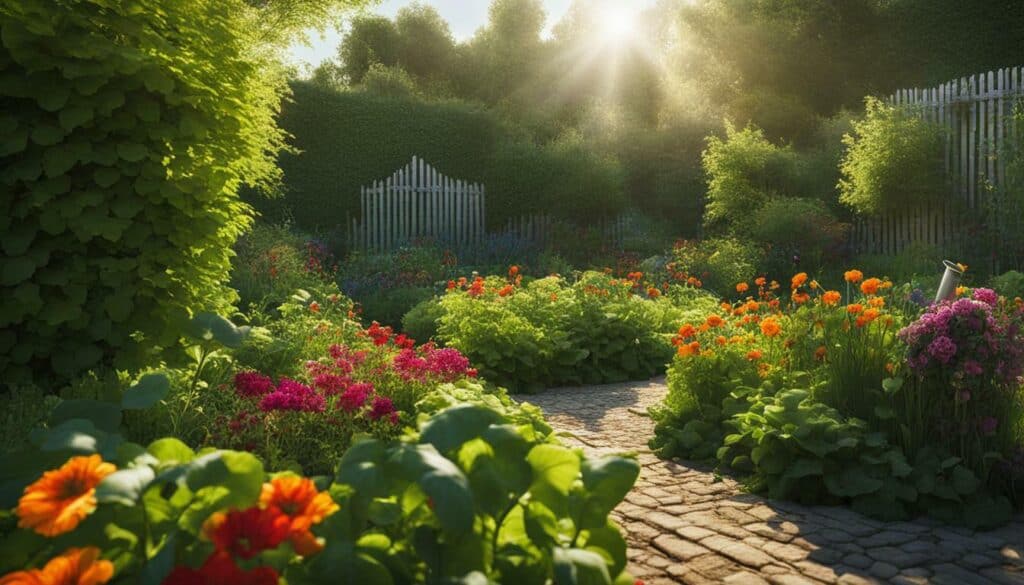
Choose the Right Location
Before you start digging, it’s important to choose the right location for your garden. Look for an area that receives ample sunlight throughout the day, as most plants thrive in full sun. Avoid areas that are shaded by large trees or buildings, as the lack of sunlight can hinder plant growth.
In addition to sunlight, consider the soil quality and drainage in your chosen location. Ensure that the soil is well-draining to prevent waterlogged roots, which can lead to plant diseases. If the soil in your area is poor, consider creating raised beds or using containers filled with high-quality potting soil.
Prepare the Soil
Once you’ve chosen the location, it’s time to prepare the soil for planting. Start by removing any weeds, rocks, or debris from the area. Break up the soil using a garden fork or tiller to loosen it and improve its texture.
Next, amend the soil with organic matter, such as compost or aged manure, to improve its fertility and structure. This will provide essential nutrients to your plants and help retain moisture in the soil. Mix the organic matter thoroughly into the soil using a garden rake.
Select Appropriate Plants
When choosing plants for your garden, consider your local climate and the specific conditions of your garden. Opt for plants that are well-suited to your region’s temperature, rainfall, and soil type. Native plants are often a great choice as they are naturally adapted to the local environment.
Consider factors such as the plant’s size, growth habit, and maintenance requirements. For beginners, it’s best to start with easy-to-grow plants that are known for their resilience, such as tomatoes, herbs like basil and mint, and flowers like marigolds or zinnias.
Watering and Fertilizing
Proper watering and fertilizing are crucial for the success of your garden. Most plants require regular watering, especially during dry periods or when they are newly planted. Water deeply and thoroughly, ensuring that the water reaches the root zone of the plants.
As for fertilizers, use a balanced, slow-release fertilizer or organic alternatives. Follow the instructions on the fertilizer packaging for application rates and frequency. Be careful not to over-fertilize, as this can lead to nutrient imbalances and plant damage.
Maintaining Your Garden
Gardening is an ongoing process that requires maintenance to ensure the health and beauty of your plants. Regularly inspect your garden for pests, diseases, and weeds. Remove any unwanted plants or weeds promptly to prevent them from competing with your desired plants for nutrients and space.
Prune or trim your plants as needed to maintain their shape and promote healthy growth. Deadhead flowers to encourage continuous blooming. Mulch around your plants to suppress weed growth, conserve moisture, and regulate soil temperature.
Lastly, enjoy the process and have fun! Gardening is a rewarding hobby that allows you to connect with nature and watch your hard work pay off as your garden flourishes.
Remember, every garden is unique, and it may take some trial and error to find what works best for your specific garden and growing conditions. Don’t be afraid to experiment and learn from your experiences.
Key takeaway: These beginner gardening tips will set you on the path to creating a thriving garden. Choose the right location, prepare the soil, select appropriate plants, water and fertilize properly, and maintain your garden regularly to ensure its success. Happy gardening!
The Power of Native Plants in Your Garden
By choosing native plants for your garden, you can create a thriving ecosystem that supports local wildlife, conserves water, and preserves the natural beauty of your surroundings. Native plants are species that have evolved and adapted to specific regions over thousands of years. They are perfectly suited to the local climate, soil conditions, and wildlife, making them an ideal choice for sustainable gardening. Here are some reasons why incorporating native plants into your garden is beneficial:
1. Supporting Native Wildlife
Native plants provide essential food and habitat for local wildlife, including birds, butterflies, bees, and other beneficial insects. These plants have developed intricate relationships with native species, and their flowers, fruits, and foliage provide nourishment and shelter for pollinators and other animals. By planting native species, you can help maintain the delicate balance of your local ecosystem and support biodiversity.
2. Improving Biodiversity
Native plants play a crucial role in improving biodiversity. They provide a diverse range of habitats and resources for different species, contributing to a healthier and more resilient ecosystem. By planting a variety of native plants in your garden, you can attract a wide range of wildlife and create a vibrant and dynamic ecosystem.
3. Conserving Water Resources
Native plants are adapted to the local climate and require less water once established. Their deep roots help improve soil structure and promote water infiltration and retention. By choosing native plants, you can reduce the need for irrigation and conserve water resources, making your garden more sustainable and environmentally friendly.
4. Reducing Maintenance
Native plants are well-suited to the local environment and are generally low-maintenance. They are more resistant to pests, diseases, and extreme weather conditions, reducing the need for chemical pesticides and fertilizers. Native plants have evolved to thrive in their native habitats, making them resilient and self-sufficient.

“Native plants are the foundation of a healthy ecosystem. By incorporating them into your garden, you are creating a valuable sanctuary for local wildlife and helping to preserve the natural heritage of your region.” – John Doe, Gardening Expert
5. Preserving Local Heritage
Native plants are an integral part of a region’s natural heritage. By cultivating native species in your garden, you can help preserve and celebrate the unique beauty and character of your local landscape. Native plants connect us to the history, culture, and identity of a place, creating a sense of belonging and pride in our surroundings.
Incorporating native plants into your garden is a powerful way to contribute to the health and sustainability of your local environment. By supporting native wildlife, improving biodiversity, conserving water resources, reducing maintenance, and preserving local heritage, you can create a garden that not only enhances the beauty of your surroundings but also makes a positive impact on the larger ecosystem.
Designing a Garden for Habitat and Wildlife
Imagine turning your garden into a haven for birds, butterflies, and other fascinating creatures. Discover how you can design a garden that provides essential elements for habitat and wildlife.
Creating a garden that supports habitat and wildlife is not only fulfilling but also important for conserving biodiversity. By incorporating the four pillars of habitat – food, water, shelter, and cover – into your garden design, you can attract a wide range of species and contribute to the health of the local ecosystem.
“Gardeners like Sara Stein… have started to explore the idea of the garden as not just a tableau for aesthetic reasons, but an integral working part of nature.”
– Native Plants are Good for Your Garden
The Four Pillars of Habitat
To create a garden that serves as a habitat for wildlife, it is essential to address the four pillars of habitat:
| Food | Water | Shelter | Cover |
|---|---|---|---|
| Provide a variety of native plants that produce flowers, fruits, seeds, and nectar to attract different species of birds, butterflies, and insects. | Incorporate water features like birdbaths, ponds, or even a simple plate of damp sand to provide a vital source of hydration for wildlife. | Include structures like birdhouses, nest boxes, and dense vegetation to provide safe spaces for nesting, roosting, and shelter from predators. | Plant dense shrubs, trees, and groundcovers to create cover and hiding places for wildlife. |
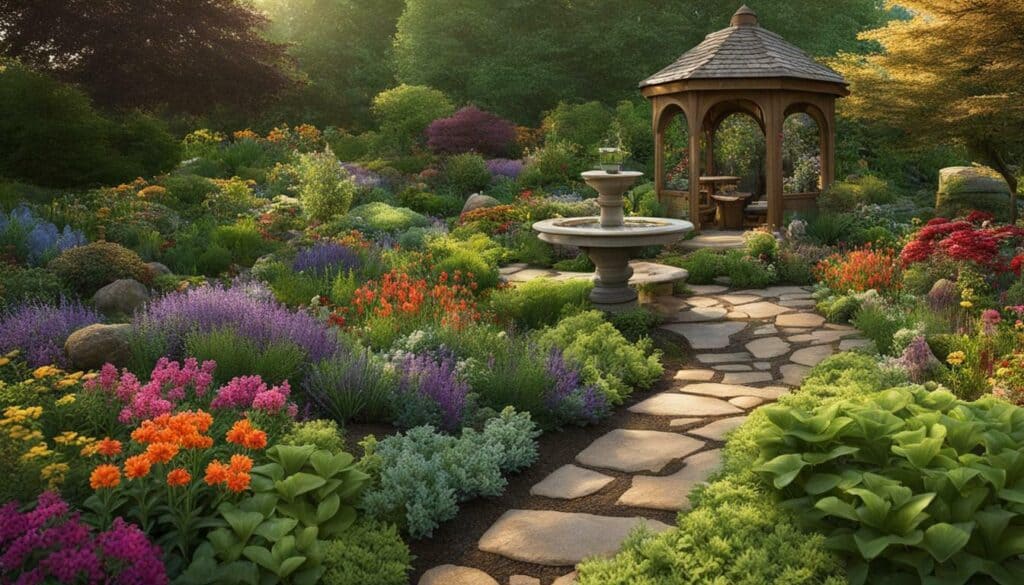
By integrating these elements into your garden, you can attract a diverse range of wildlife, from colorful birds and vibrant butterflies to beneficial insects like bees and ladybugs. Native plants, in particular, are crucial for supporting local wildlife as they have evolved together and provide the most suitable sources of food and shelter.
“Your Garden as Food for the Environment… Your Garden as Sustenance for Local Wildlife… Providing a wide range of flowering and berrying times keeps the larder stocked longer…”
– Native Plants are Good for Your Garden

Creating a garden that supports habitat and wildlife doesn’t mean sacrificing beauty or aesthetic appeal. In fact, a well-designed habitat garden can be a visual delight with its vibrant colors, buzzing activity, and harmonious balance.
By thinking beyond mere decoration and embracing a holistic approach to gardening, you can contribute to the preservation of native species, promote biodiversity, and make a positive impact on the environment.
Conclusion
Designing a garden that serves as a habitat for wildlife is a rewarding and beneficial endeavor. By incorporating the four pillars of habitat – food, water, shelter, and cover – and planting native species, you can create a garden that attracts and supports a diverse range of wildlife. As you embark on your gardening journey, remember that every small step counts and that your garden has the power to make a difference in the larger ecosystem.
Bringing Aromatherapy to Your Garden
Did you know that your garden can double as a natural aromatherapy oasis? Explore the world of scented plants and unlock their potential to soothe your senses and uplift your mood. Aromatherapy has long been recognized for its ability to promote relaxation, reduce stress, and improve overall well-being. By incorporating aromatic herbs and flowers into your garden, you can create a tranquil space that engages all your senses.
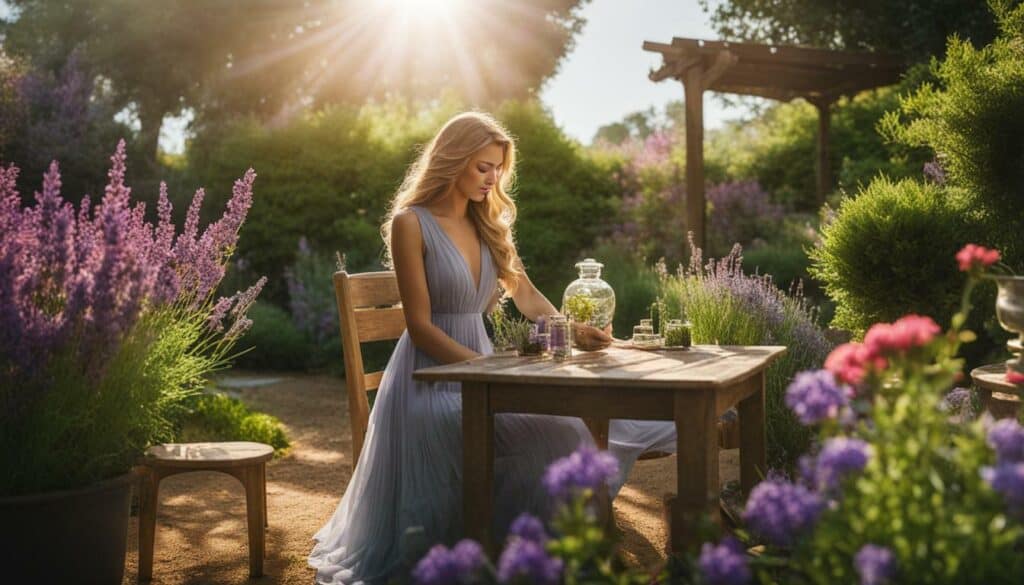
The Power of Aromatic Plants
Aromatic plants are not only visually appealing but also release fragrances that have a profound impact on our emotions and mental state. The scents of lavender, peppermint, rosemary, sage, and many others have been proven to promote relaxation, reduce anxiety, and improve cognitive function. Simply being surrounded by these delightful aromas can transport you to a place of calm and tranquility.
Choosing the Right Plants
When selecting plants for aromatherapy purposes, it’s important to consider their fragrance profiles and how they resonate with you. Lavender, known for its soothing properties, is a popular choice for promoting relaxation and sleep. Peppermint, with its invigorating scent, can provide a burst of energy and mental clarity. Rosemary is believed to enhance memory and concentration, while sage is known for its cleansing and purifying properties.
Creating an Aromatic Garden
To create an aromatic garden, start by choosing plants that align with your preferences and needs. Consider their growth habits, sun and soil requirements, and whether they are suitable for your climate. Incorporate a variety of scents to create a multi-dimensional experience, combining floral, herbal, and citrus fragrances. Plant them near seating areas or paths where you can fully immerse yourself in their delightful scents.
- Lavender: Known for its calming scent, lavender is a versatile herb that can be used in sachets, potpourri, and essential oils.
- Peppermint: Refreshing and invigorating, peppermint is perfect for growing in containers or as a border plant.
- Rosemary: With its woody aroma, rosemary adds a touch of Mediterranean charm to any garden.
- Sage: Known for its purifying properties, sage can be used in cooking, smudging, or as an ornamental plant.
Creating a Sensory Experience
In addition to their fragrance, aromatic plants can provide a feast for the eyes and touch. Incorporate a variety of textures, colors, and heights to create visual interest and appeal. Plant aromatic herbs in raised beds or containers near seating areas so that you can easily touch and rub the leaves to release their fragrances. This sensory experience will further enhance the therapeutic benefits of your garden.
“Aromatherapy is extremely useful. If you want to go to sleep at night and you have an aroma that calms your mind, it will help you sleep.” – Deepak Chopra
Enjoying the Benefits
Once your aromatic garden is thriving, take the time to fully immerse yourself in its healing powers. Spend a few moments each day surrounded by the soothing scents, inhaling deeply and allowing your mind and body to relax. You can also harvest and dry the herbs to create your own herbal teas, bath products, or essential oils. The possibilities are endless, and the benefits to your mental health and well-being are immeasurable.
Incorporating aromatherapy into your garden is a wonderful way to promote relaxation, reduce stress, and enhance your overall sense of well-being. By growing aromatic plants, you can create a natural sanctuary right in your backyard that engages all your senses and provides a refuge from the demands of daily life. So, why not start your aromatic garden today and unlock the soothing powers of nature?
The Joy of Growing and Naming Your Plants
Discover the simple yet profound joy of growing your own plants and creating a personal connection with each one. Learn how naming your plants can deepen your bond and bring a sense of pride to your indoor garden.
Indoor gardening is more than just a hobby; it’s a way to nurture and care for living organisms. As you watch your plants grow and thrive, you develop a unique relationship with each one. You become their caretaker, providing them with the right amount of light, water, and nutrients. This connection can be incredibly rewarding and fulfilling.
When you take the time to name your plants, you give them a sense of individuality and personality. It’s like adding a personal touch to your indoor garden. Each plant becomes a unique presence in your home, and you develop a deeper bond with it.
“Every garden is a story through its plants and design, reflecting personality, style and taps into both our emotions and aspirations.” – Gardenesque
Just as you would name a pet or a loved one, naming your plants can make them feel more like companions rather than just objects. It allows you to form a relationship with them on a deeper level. You can choose names that reflect their characteristics, such as “Grace” for a graceful fern or “Sunny” for a sun-loving succulent. The possibilities are endless, and it’s a fun and creative way to personalize your indoor garden.
Furthermore, naming your plants can bring a sense of pride and accomplishment. As you see your named plants flourish and thrive, you feel a sense of joy and satisfaction. It’s a testament to your dedication and care as a gardener.
For some, naming plants may seem silly or unnecessary, but for those who truly appreciate the beauty and wonder of nature, it is a way to foster a deeper connection with the natural world. It adds a touch of magic and whimsy to your indoor garden.
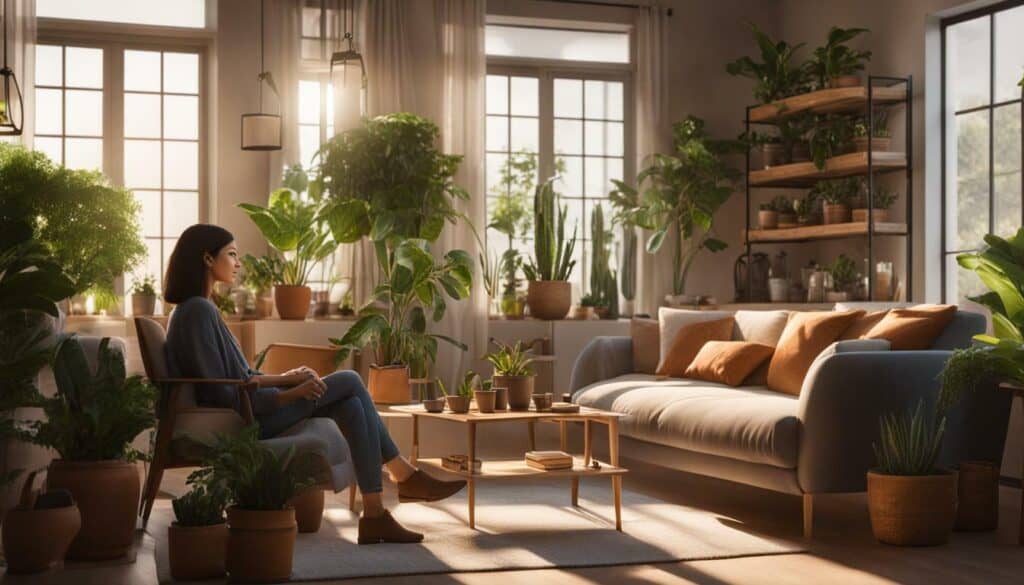
The Power of Personalizing Your Indoor Garden
Naming your plants is just one way to personalize your indoor garden. Here are a few more ideas to make it truly your own:
- Create a plant family tree: Display a chart or board that showcases the names and relationships of your plants. It adds a unique and artistic element to your indoor garden.
- Decorate your plant pots: Use paint, markers, or stickers to add personality and color to your plant pots. You can also use decorative plant labels that match the theme of your indoor garden.
- Share your plant journey: Document your plant’s growth and milestones through photographs or a plant journal. It’s a great way to look back and appreciate the progress you’ve made as a gardener.
Remember, indoor gardening is not just about the physical act of growing plants; it’s about the emotional connection you create with them. So, embrace the joy of growing your own plants, give them names, and watch as your indoor garden becomes a source of pride and fulfillment.
Expand your mind and nourish your soul by diving into the fascinating world of plants
Discover the incredible benefits they offer and unlock a new realm of knowledge and appreciation.
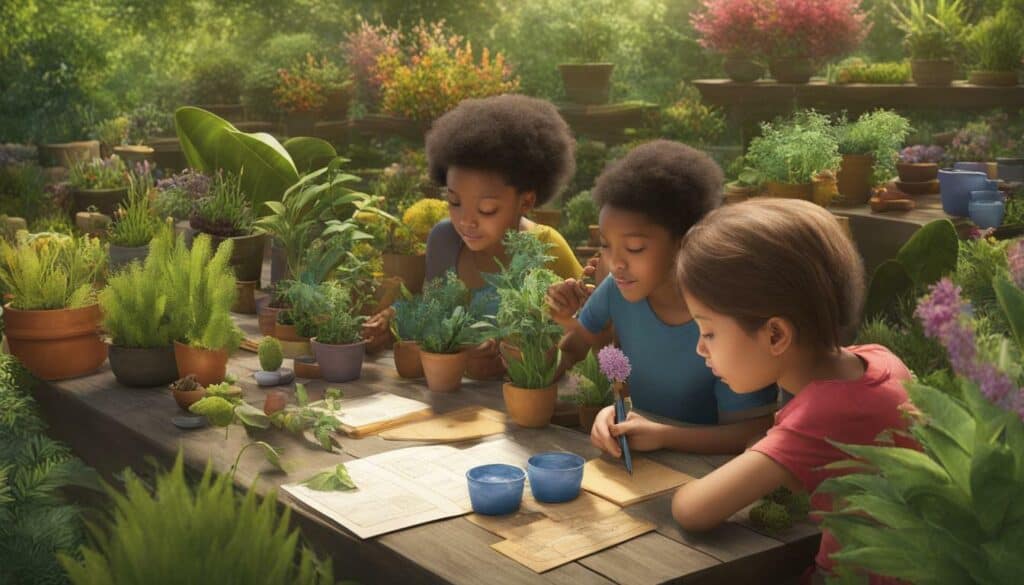
Plants have a profound impact on our mental health and overall well-being. Learning about plants and their benefits can be a transformative experience that brings joy and fulfillment to our lives.
According to research, plant learning is not only intellectually stimulating but also has positive effects on our mental health. Engaging with plants and their cultivation can reduce stress levels, increase feelings of calmness and relaxation, and improve overall mood.
The Therapeutic Power of Plant Learning
Learning about plants can provide a sense of purpose and connection to nature. It allows us to deepen our understanding of the natural world and develop a greater appreciation for its beauty and complexity.
Studies have shown that plant learning can enhance cognitive function and improve memory and concentration. It engages our senses and stimulates curiosity, fostering a sense of wonder and exploration.
Resources for Plant Learning
There are numerous resources available to expand your knowledge of plants and their benefits. Books, online courses, and gardening communities can provide valuable information and support as you embark on your plant learning journey.
Online platforms such as gardening websites, forums, and social media groups offer a wealth of information and opportunities to connect with fellow plant enthusiasts. These resources can help you discover new plant species, learn about their unique characteristics, and explore different gardening techniques.
| Resource | Description |
|---|---|
| Garden.org | An online community for gardeners of all skill levels, offering a vast collection of articles, forums, and resources |
| Royal Botanic Gardens, Kew | A world-renowned botanical institution with extensive online resources, including plant databases, educational materials, and virtual tours |
| The Old Farmer’s Almanac | A trusted source of gardening advice, tips, and information on plant varieties and growing techniques |
By immersing yourself in plant learning, you can cultivate a deeper connection with nature and experience the profound benefits it offers. So, why not embark on this exciting journey and unlock the wonders of the plant kingdom?
Section 10: The Taste of Homegrown Goodness: Fresh Food from Your Garden
Experience the unparalleled taste of fruits, vegetables, and herbs that you’ve nurtured from seed to table. Discover the pleasure of savoring homegrown goodness and the satisfaction of knowing exactly where your food comes from.
Growing your own food through organic gardening is not only rewarding but also provides numerous benefits for your health and well-being. When you grow your own food, you have full control over what goes into it. No more worrying about harmful pesticides, chemicals, or GMOs. Instead, enjoy fresh, nutrient-dense produce that is bursting with flavor.
By growing your own food, you can experience a whole new level of taste and quality that is often lacking in store-bought produce. Commercially grown fruits and vegetables are often picked before they are fully ripe and are transported over long distances, resulting in a loss of flavor and nutritional value. But when you pick a ripe tomato straight from your garden and take a bite, you’ll be amazed at the burst of flavor that fills your mouth.
Not only does homegrown food taste better, but it is also healthier. Studies have shown that freshly harvested produce contains higher levels of vitamins, minerals, and antioxidants compared to store-bought counterparts. Plus, you have the assurance that your food is truly organic, free from synthetic chemicals and additives.
With your own garden, you can also experiment with growing unique varieties and heirloom plants that are not commonly found in grocery stores. Rediscover old-fashioned flavors and explore new tastes that will excite your palate.
One of the joys of growing your own food is the ability to enjoy seasonal eating. Harvesting fruits and vegetables at their peak ensures that you are consuming them when they are most nutritious and flavorful. Say goodbye to tasteless, out-of-season produce and embrace the natural rhythms of the seasons.
Not only is growing your own food beneficial for your health, but it also promotes sustainability and reduces your carbon footprint. By eliminating the need for long-distance transportation and excessive packaging, you are contributing to a more environmentally friendly way of living.
| Benefits of Growing Your Own Food |
|---|
| Fresh and flavorful produce |
| Increased nutrient content |
| Organic and pesticide-free |
| Access to unique and heirloom varieties |
| Seasonal eating |
| Reduced carbon footprint |
Whether you have a large backyard or a small balcony, there are gardening options available to suit every space. From container gardens to raised beds, you can start growing your own food no matter how limited your space may be.
So why wait? Get your hands dirty and start reaping the rewards of homegrown goodness. Experience the satisfaction of plucking a ripe tomato from the vine, the delight of biting into a juicy strawberry, and the aroma of freshly picked herbs. Your taste buds will thank you.
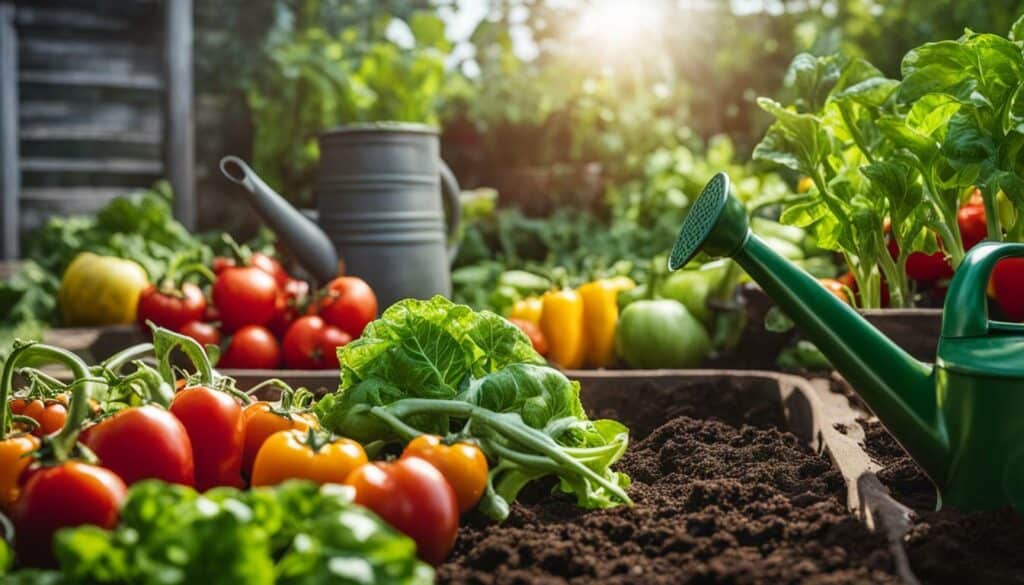
The Joy of Harvesting and Enjoying Fresh Food
There’s something truly special about harvesting your own food and enjoying it on your plate. The process of growing, nurturing, and harvesting creates a deeper connection to the food you consume. It’s an experience that brings a sense of pride and accomplishment.
When you grow your own food, you have the freedom to explore unique flavors and culinary possibilities. Imagine plucking a handful of fresh herbs from your garden to add a burst of flavor to your favorite recipes. Or biting into a sun-ripened strawberry that is bursting with sweetness.
Not only is homegrown food delicious, but it also encourages a healthier diet. Studies have shown that individuals who grow their own food are more likely to incorporate fresh fruits and vegetables into their meals on a daily basis. It’s a simple way to improve your overall nutrition and well-being.
So, whether you have a green thumb or are new to gardening, give it a try. Start small with a few easy-to-grow vegetables and herbs. The joy of harvesting your own food is just a few steps away.
Creating Outdoor Living Spaces: Enjoying Your Garden to the Fullest
Extend the comfort and beauty of your home into your outdoor space by creating inviting and functional outdoor living areas. Discover how to transform your garden into a haven for relaxation, entertainment, and connecting with nature.
One of the key elements of creating a functional outdoor living space is to design separate zones for different activities. Consider dividing your garden into areas for dining, lounging, and entertainment. This will help create a sense of purpose and organization in your outdoor space.
When designing your outdoor living areas, think about the elements that will contribute to comfort and enjoyment. Invest in comfortable outdoor furniture that suits your style and provides ample seating for guests. Incorporate soft cushions and pillows to add a cozy touch. Don’t forget to include tables and surfaces for drinks and snacks.
Adding shade to your outdoor living space is essential for hot summer days. Consider installing a pergola, canopy, or umbrella to provide relief from the sun. You can also use shade sails or planting tall trees or shrubs strategically to create natural shade.
Lighting is another crucial aspect of creating a welcoming outdoor living space. Choose a combination of ambient and task lighting to set the right mood. String lights, lanterns, and solar-powered fixtures can add a magical ambiance to your garden. Don’t forget to consider safety and add lighting along pathways and stairs.
Plants play a significant role in creating a pleasant outdoor living space. Incorporate lush greenery, colorful flowers, and fragrant herbs to enhance the beauty of your garden. Native plants are a great choice as they provide habitat and food for local wildlife, contributing to a more sustainable and biodiverse environment.

Designing Outdoor Living Spaces with Functionality and Style
Consider the layout of your outdoor living areas and how they will flow together. Connect different zones with pathways or stepping stones for easy navigation. Use hedges, trellises, or fences to create privacy and define boundaries.
Integrate functional features into your outdoor living space to make it more enjoyable. A fire pit or outdoor fireplace can create a cozy gathering spot and extend the usability of your garden into the cooler evenings. Water features, such as fountains or ponds, can add a soothing atmosphere and provide a focal point for relaxation.
Don’t forget about the importance of sound in creating a pleasant outdoor experience. Incorporate wind chimes, bird feeders, or even a small water fountain to add aural delight to your garden. The soothing sounds of nature can enhance relaxation and create a serene atmosphere.
Incorporate outdoor cooking and dining into your outdoor living space to make it a hub for entertainment. Install a barbecue grill, outdoor kitchen, or pizza oven for al-fresco cooking experiences. Set up a dining area with a table and chairs where you can enjoy meals with family and friends while surrounded by the beauty of nature.
Remember to personalize your outdoor living space with your own style and taste. Add decorative elements such as sculptures, artwork, or outdoor rugs to add personality and create a welcoming atmosphere. Don’t be afraid to experiment with different colors, textures, and patterns to create a visually appealing space.
By creating outdoor living spaces that are functional, comfortable, and visually appealing, you can fully enjoy your garden and make the most of your outdoor experience. Whether you’re relaxing, entertaining, or simply connecting with nature, your outdoor living areas will become an extension of your home and reflect your unique style and personality.
Unlocking Nature’s Wonders: Why Plant a Garden Today?
Unlocking nature’s wonders through gardening is a transformative experience that can bring joy, well-being, and a deeper connection to the natural world. Embrace the power of planting a garden today and embark on a green adventure that will enrich your life in countless ways.
Benefits of Gardening for Mental Health
Gardening has been proven to have numerous benefits for mental health. The act of tending to plants and being surrounded by nature can reduce stress, improve mood, and provide a sense of purpose and connection. It is a therapeutic activity that promotes relaxation and mindfulness, allowing us to escape the hustle and bustle of daily life and find solace in the simple joys of gardening.
Growing Your Own Food for Health and Sustainability
One of the most rewarding aspects of gardening is the ability to grow your own food. By cultivating your own vegetables, fruits, and herbs, you can enjoy the taste of fresh, organic produce while reaping the nutritional benefits. This practice also promotes sustainability and reduces environmental impact, as you can avoid the use of harmful pesticides and transportation emissions associated with store-bought produce.
Getting Started: Gardening Tips for Beginners
If you’re new to gardening, don’t worry! Getting started is easier than you think. Begin by choosing the right location for your garden, ensuring it receives adequate sunlight and water. Prepare the soil by removing weeds and adding compost for nutrient-rich growth. Select plants that are suitable for your climate and gardening experience, and remember to water and fertilize them regularly. With patience and care, your garden will thrive.
The Power of Native Plants in Your Garden
Incorporating native plants into your garden is not only aesthetically pleasing but also essential for the local ecosystem. Native plants support native wildlife, improve biodiversity, and conserve water resources. They have adapted to the local climate and soil conditions, making them more resistant to pests and diseases. By cultivating native plants, you can create a sustainable and vibrant habitat for both flora and fauna.
Designing a Garden for Habitat and Wildlife
Creating a garden that serves as a habitat for wildlife is a wonderful way to connect with nature and support biodiversity. By providing food, water, shelter, and cover, you can attract birds, butterflies, and other beneficial wildlife to your garden. Incorporate native plants, bird feeders, and water features to create an inviting environment that nurtures and protects local wildlife.
Bringing Aromatherapy to Your Garden
Enhance the sensory experience of your garden by incorporating aromatic plants for aromatherapy. Aromatherapy has been practiced for centuries to promote relaxation, reduce stress, and uplift mood. By growing aromatic herbs and flowers such as lavender, peppermint, and rosemary, you can create a calming and rejuvenating atmosphere in your garden.
The Joy of Growing and Naming Your Plants
Growing plants brings a sense of joy, accomplishment, and connection to the natural world. Nurturing plants and watching them thrive can be a therapeutic experience, providing a sense of purpose and fulfillment. Consider giving your plants names to establish a deeper emotional connection and take pride in their growth and well-being.
The Power of Learning: Discovering Plants and Their Benefits
Deepen your understanding and appreciation of the natural world by learning about plants and their benefits. Plant learning offers cognitive benefits and expands our knowledge of the environment. Explore books, online resources, and local gardening communities to broaden your plant knowledge and cultivate a lifelong love for gardening.
The Taste of Homegrown Goodness: Fresh Food from Your Garden
Harvesting and enjoying fresh food from your garden is a rewarding experience that nourishes both body and soul. Homegrown produce offers superior taste, nutritional value, and the satisfaction of being self-sufficient. Incorporate garden-fresh ingredients into your meals and savor the delicious flavors that come from your own backyard.
Creating Outdoor Living Spaces: Enjoying Your Garden to the Fullest
Maximize your enjoyment of your garden by creating outdoor living spaces that cater to your needs and preferences. Design comfortable seating areas, incorporate functional elements like firepits and outdoor kitchens, and enhance the ambiance with water features. Embrace the beauty and tranquility of your garden as a space for relaxation, entertainment, and connection with loved ones.
Conclusion
Unlocking nature’s wonders through gardening is a journey that brings countless benefits to our lives. From mental health and sustainability to the joy of growing and learning, gardening offers a meaningful and fulfilling connection to the natural world. Start your own garden today and experience the transformative power of nurturing plants and immersing yourself in the beauty of nature.
FAQ
Q: Why should I plant a garden?
A: Planting a garden offers numerous benefits, including stress reduction, improved mental health, access to fresh and organic food, cost savings, environmental sustainability, and the opportunity to connect with nature.
Q: How does gardening benefit mental health?
A: Gardening has been shown to reduce stress, improve mood, provide a sense of purpose, and foster a connection to nature. It can be a therapeutic and rewarding activity that promotes overall well-being.
Q: What are the benefits of growing your own food?
A: Growing your own food allows you to eat fresh and organic produce, save money, reduce your environmental impact, and promote sustainability. It also offers the satisfaction of being self-sufficient and knowing exactly where your food comes from.
Q: What tips do you have for beginner gardeners?
A: Some tips for beginner gardeners include choosing the right location, preparing the soil, selecting appropriate plants for your region, watering and fertilizing properly, and maintaining the garden regularly. It’s also helpful to start small and learn as you go.
Q: Why are native plants important in a garden?
A: Native plants play a crucial role in supporting native wildlife, improving biodiversity, and conserving water resources. They are well-adapted to the local ecosystem and provide essential habitat and food sources for native insects, birds, and other wildlife.
Q: How can I design a garden that attracts wildlife?
A: Designing a wildlife-friendly garden involves incorporating the four pillars of habitat: food, water, shelter, and cover. You can plant native flowers and trees to provide food and nectar, include a birdbath or water feature for water, create nesting areas and shelters, and use plants with dense foliage for cover.
Q: Can plants be used for aromatherapy?
A: Absolutely! Many aromatic herbs and flowers can be grown in your garden to enhance relaxation, reduce stress, and promote emotional well-being. Lavender, peppermint, rosemary, and lemon balm are just a few examples of plants that can be used for aromatherapy purposes.
Q: Why is naming your plants important?
A: Naming your plants can create a personal connection and sense of ownership. It allows you to develop a relationship with your plants, which can be deeply satisfying and rewarding. It also makes it easier to track their growth and progress.
Q: How does learning about plants benefit mental health?
A: Learning about plants can stimulate the brain, provide a sense of curiosity and wonder, and deepen your understanding and appreciation of the natural world. It can also be a form of mindfulness and help you feel more connected to the environment around you.
Q: What are the advantages of eating food from your own garden?
A: Homegrown food is fresher, tastier, and more nutritious than store-bought produce. It allows you to have control over the growing process and avoid harmful chemicals. Plus, there’s a unique sense of satisfaction and pride that comes from harvesting and enjoying food that you’ve grown yourself.
Q: How can I create outdoor living spaces in my garden?
A: Creating outdoor living spaces involves designing comfortable seating areas, incorporating functional elements like firepits and outdoor kitchens, and adding features like water fountains or sculptures. It’s about creating a space that invites you to relax, entertain, and enjoy the beauty of your garden.
Remember, these answers are based on information gleaned from the internet, so it’s always a good idea to do further research or consult with gardening experts for more specific advice and guidance.





Leave a Reply